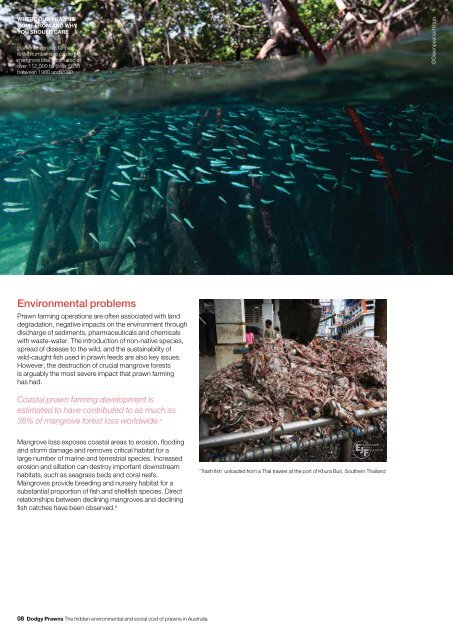Prawns
UREzh60p
UREzh60p
You also want an ePaper? Increase the reach of your titles
YUMPU automatically turns print PDFs into web optimized ePapers that Google loves.
WHERE OUR PRAWNS<br />
COME FROM AND WHY<br />
YOU SHOULD CARE<br />
In Vietnam prawn farming<br />
is the number one cause of<br />
mangrove loss, estimated at<br />
over 112,000 ha (over 58%)<br />
between 1980 and 2000.<br />
©Greenpeace/Hilton<br />
Environmental problems<br />
Prawn farming operations are often associated with land<br />
degradation, negative impacts on the environment through<br />
discharge of sediments, pharmaceuticals and chemicals<br />
with waste-water. The introduction of non-native species,<br />
spread of disease to the wild, and the sustainability of<br />
wild-caught fish used in prawn feeds are also key issues.<br />
However, the destruction of crucial mangrove forests<br />
is arguably the most severe impact that prawn farming<br />
has had.<br />
Coastal prawn farming development is<br />
estimated to have contributed to as much as<br />
38% of mangrove forest loss worldwide. 8<br />
Mangrove loss exposes coastal areas to erosion, flooding<br />
and storm damage and removes critical habitat for a<br />
large number of marine and terrestrial species. Increased<br />
erosion and siltation can destroy important downstream<br />
habitats, such as seagrass beds and coral reefs.<br />
Mangroves provide breeding and nursery habitat for a<br />
substantial proportion of fish and shellfish species. Direct<br />
relationships between declining mangroves and declining<br />
fish catches have been observed. 9<br />
‘Trash fish’ unloaded from a Thai trawler at the port of Khura Buri, Southern Thailand<br />
08 Dodgy <strong>Prawns</strong> The hidden environmental and social cost of prawns in Australia


